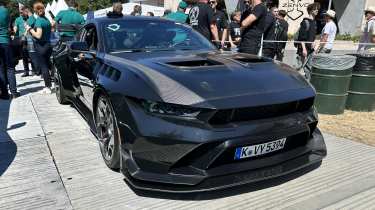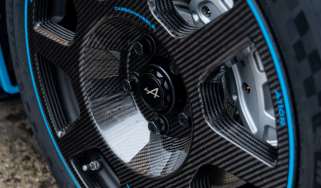The Ford Mustang GTD is America's answer to the Porsche 911 GT3 RS, and we've been onboard
As first customer cars hit the road, we jump onboard the Multimatic-developed Mustang GTD with Le Mans driver Dirk Müller
When Ford announced that the Mustang GTD had lapped the Nordschleife in 6min 57.685sec, it was very keen to emphasise that there was more to come, and it proved just that with a 6min 52.072 lap. Now, as first US customer cars hit the road, we've been onboard the very car that made that record lap, with Dirk Müller at the wheel.
Slotting just behind the Lamborghini Huracán Performante on the fastest lap list, it’s the fourth fastest vehicle in the production sports car class, ahead of the 992 Porsche 911 GT3 Manthey Performance Kit (6:55.737, recorded in 2022) and 992 Porsche 911 GT3 (6:59.93, recorded in 2020). If its looks aren't enough, this time certainly proves the GTD is more than just a tuned up Mustang GT.
Ford Mustang GTD: ride impressions
While we'll have to wait a little longer to get behind the wheel of a final production example, evo Senior Staff Writer Sam Jenkins spent time in the passenger seat for a flat-out run up the Goodwood Festival of Speed hillclimb: 'Presence is something the GTD has in abundance, even in this test car configuration complete with the scars from its time on track. Inside, it's very familiar if you've ever been aboard a Mustang GT, with the dash, steering wheel and door cards carried over wholesale bar the use of bespoke extended shift paddles and that central selector wheel on the transmission tunnel. In place of those rear seats, though, is a window to the inboard suspension system, something I certainly won't have the time to watch in action during the run...'
'The launch is important for a quick Goodwood hillclimb run, and with over 800bhp to the rear wheels, this is not easy to perfect with the GTD. Having tested the traction control the previous day, Müller is instead opting for traction off for this run in hopes of a better start. Launch control engaged, light green and of course there's a flourish of wheelspin, but the GTD is brutally quick once it finds traction. Shifts are near-sequential crisp with a satisfying throttle cut on the upshift, and it feels every one of its 815bhp thanks to its torque-rich supercharged delivery.'
'Unlike some high-power Mustangs, the GTD's chassis feels up for the job. Resolutely flat and composed even on the less-than-perfect and occasionally low-traction surfaces of the Goodwood hillclimb, 54 seconds is all it took to reach the top. This then became 50.78 seconds in the final timed session, making it the fastest road legal car up the hill in Sunday's shootout. Now I just need to get behind the wheel.'
Powertrain
The GTD is a road-legal Mustang production car like no other. It’s based on the Mustang GT3 racing car (making the GTD a road car developed from a racing car, which itself is an extreme development of the Mustang Dark Horse production car), and features carbonfibre bodywork, active aerodynamics, a bespoke re-engineered rear end and transaxle transmission. Its 5.2-litre supercharged V8 develops 815bhp – more than a McLaren Senna GTR – and a 664lb ft peak torque figure. Top speed is stated to be 202mph.
The V8 is a development of the one found in the previous-generation Mustang GT500, though its 7650rpm rev limit is 100rpm higher than before. It features a revised intake and exhaust – the latter made from titanium as standard – as well as a smaller supercharger pulley and a dry-sump oil system.
The GTD – which stands for ‘GT Daytona,’ the name of the GT3-equivalent class in the IMSA sportscar championship in North America – is the fruit of a joint development project between Ford’s and Multimatic, which has also engineered the Mustang GT3 racer. It is scheduled for a low- (but not that low) volume production run, of up to 1000 cars. Following its European debut at Le Mans, Ford announced that the first European cars will enter production in mid-2025, costing each buyer from £315,000.
Supercharging is banned in GT3 racing, and the GTD takes advantage of the lack of regulations in other ways too, including semi-active suspension and active aerodynamics. That 202mph top speed is aided in part by the GTD’s drag reduction system, which can stall the rear wing, as well as flaps under the front of the car. In place of a practical boot space is the GTD’s semi-active DSSV (Dynamic Suspensions Spool Valve) Multimatic suspension and transaxle cooling system, similar to the system introduced on the Ford GT. The Ferrari Purosangue also makes use of a development of Multimatic’s DSSV dampers. The GTD’s hydraulically controlled system can alter ride height by almost 40mm on the fly, with the driver also able to adjust spring rate to suit the conditions. There's even a neat window where the rear seats would usually be, putting its high-tech suspension proudly on display.
Chassis
On the front axle, Multimatic has opted for unequal-length wishbones to aid lateral stiffness. The multi-link rear suspension uses a pushrod and rocker arm architecture, arranging its trick inboard shock absorbers and springs in a horizontal cross pattern.
Driving the rear wheels only via an eight-speed dual-clutch transmission, the GTD has a new variable traction control system. Elements such as a carbonfibre driveshaft (also seen in the GT500) keep weight to a minimum (although an official kerb weight has yet to be publicly confirmed at the time of writing), while reducing the centre of gravity and contributing to near 50:50 weight distribution. Dramatic aero aside, a track width almost four inches wider than that of the standard Mustang GT certainly lends the GTD some extra visual purpose.
At each corner are 20-inch forged aluminium or magnesium wheels wrapped in mammoth 325 and 345-section tyres front and rear – for comparison, the Ford GT’s rear tyres are the same width as the GTD’s fronts. Behind those wheels are Brembo carbon ceramic brakes, equipped with cooling ducts at the rear below that trick new suspension.
Inside, Ford has opted for track-oriented ‘Miko suede’ (an Alcantara alternative), with leather and carbonfibre also featured throughout. Rear seats are removed for weight savings and an increase in cargo space, with the front two swapped for supportive Recaros. The paddle shifters are 3D-printed from titanium, with the rotary shifter and numbered plaque made from retired parts from Lockheed Martin’s F-22 fighter jet.
Nürburgring lap
evo caught up with the Ford Mustang GTD’s chief programme engineer, Greg Goodall, for the inside story on the original 6min 57 lap.
Ford has celebrated the lap time, which was achieved with Multimatic Motorsports driver Dirk Müller at the wheel, with the publication of a YouTube documentary titled Road to the Ring. The film, which can be viewed below, features input from chief programme engineer Greg Goodall, plus Multimatic CTO Larry Holt and Ford’s CEO Jim Farley.
Speaking to evo, Goodall describes the GTD’s engineering team as being ‘happy but not content’ with the 6:57.685 lap time – which was achieved in August 2024 – as all of the timed lap attempts thus far have been curtailed by poor weather. ‘It's a huge accomplishment,’ he acknowledges, ‘but we're not done working: we’re determined to go back and beat the time that we’ve run [so far]. We left some time on the track; we really only got an hour and 45 minutes of “real” lap times, where we ran three total laps, all of which were under seven minutes. That was the first time that Dirk was on the track running at ten tenths by himself. So we learned a lot, and the car has become much faster now – and unfortunately, it has rained out multiple times since we set the lap time. But we plan on going back and really delivering on what this car can do.’
Part of the logistical difficulty in setting a production car lap time at the Nürburgring is that time slots must be booked well in advance, without knowing what the weather (infamously changeable in the Eifels) or track conditions will be like. Goodall explains that it rained after Müller first timed lap, and the fastest lap came after that. They’ve been back multiple times since ‘and not actually run a single lap because of either rain live while we’re there, or the track being damp from rain the night before without the possibility to get it dry.’ And with a track so long, it can rain in one section while the rest of the circuit is bone dry…
It took until April for what was only the team’s second good-weather track test since August 2024, for Müller to extract more from the GTD – a 5.5-second saving off that original lap time, for 6min 52.072
The Mustang GTD’s development has been ‘about a two-year project,’ Goodall explains, and the sub-seven-minute benchmark has been a key target from the beginning. ‘The mission from day one was always this lap time,’ he says. ‘Every decision we made on the programme in terms of content, the aero design of all of the exterior surfaces; everything was done in the context of “what does this mean to lap time?” Every time we moved the studio surface by a millimeter, we're re-running all of our aerodynamic simulations to make sure that we're doing the right thing for the car. And we literally did hundreds of simulations of aero just to make sure that we were getting the most we could out of this car. And then a bunch of lap time simulations. But everything was with the expectation that we were going to break the seven-minute lap time. So you can imagine the years of build-up for a one-hour 45-minute window, the emotions going through the team… It was an intense effort.’
Given that pressure, why was a sub-seven-minute mission decided as a key target for this car?
‘The Mustang is raced globally every weekend somewhere around the world,’ Goodall says. ‘And the GT3 race car was developed from the Dark Horse Mustang road car. Where this [lap time mission] really came from is, if we're going to race Mustang globally against the best in the world, then we should put a product out there that can compete globally on the street. The intention of this GTD was really to show all of our European competitors we're serious in this space, to go compete with Porsche, with Aston, with AMG. And Nürburgring was the way to do that. It’s something that takes the fight right to their backyard and challenges them at something that they’ve done well for many, many years. This is really our first attempt at tuning and developing a car. So from the very beginning, the question was, “What does the lap time need to be to show that we’re serious?” And that's where we came up with [the notion that] we really need to be under seven minutes for this to be a credible product. We, of course, set even tougher internal goals, and that's why we're still going back. We want to do even more.
‘But from the very beginning, it was: “Here's the lap time that we need to set – what content does it take to deliver that kind of lap time?” It wasn't an outcome; it wasn't a “let's put the best pieces together and see what we can do”; it's “what does it take, from horsepower, from aero, from tyre grip.” So it literally went in a stair step, building those components, all with the intention of creating a credible product to compete with these supercars.’
One such benchmark car is the Porsche 911 GT3 RS, which has lapped the Ring in 6min 49.3sec. That car has been directly referenced in some of Ford’s publicity material on the GTD thus far, including mentioning that the GTD’s specific power output exceeds the Porsche’s horsepower-per-litre figure.
‘Sure it was [a benchmark],’ Goodall acknowledges of the GT3 RS. ‘It’s a really good car. We don't try to compete with people that we don't respect,’ he adds. ‘It’s a good car, so we wanted to show the world that we can compete and go toe to toe. And I can tell you with all integrity that I think the experience of our car, what it’s capable of on the track, [how it] feels on the streets, I think we've gone toe to toe with these guys, and it's really exciting for us, especially as it’s the first time we really tried to build up a car for the Nürburgring. We’ve run other cars out there but this is the first one we've actually done with the intent of setting a lap time.’
Goodall describes the work between Ford Performance and Multimatic on the GTD as ‘a true partnership project.’
‘Multimatic is incredibly talented with suspension, a lot of the powertrain is Ford-developed, we used our Ford Studio team to develop all the surfaces and execute the aero strategy. It’s a team that’s used the strengths of both companies. Our [Ford Performance’s] vehicle dynamics engineers and Multimatic’s vehicle dynamics engineers were hand-in-hand at the track developing this car. There are parts on the car that are developed by Multimatic, there are parts in the car that are developed by Ford Performance. It truly is a partnership project, and any partnership has its own challenges, of trying to figure out how you're going to integrate all of this new technology into an existing Mustang architecture.
‘What also makes it challenging was the first two years of the project were all under NDA (non-disclosure agreement). We had a lot of engineers working on the project where their bosses didn't even know…'
With Ford Performance and Multimatic also collaborating on the Mustang GT3 racing car, that enabled transfer of learnings to the GTD road car too. ‘When we took the GT3 race car into the aero tunnel, the learnings for that would feed back into the race car and feed right back into GTD as well, or vice versa,’ Goodall says. ‘We really, truly developed them in parallel. So you take all the good stuff that we learned developing the race car, you put technology into the car that you can't use in racing – like superchargers, active aero, adaptive suspension, things like that – and you really get the best of both worlds. You get a car that is truly race-inspired but is comfortable and legal to drive on the streets.’
While aerodynamics of GT3 racing cars are strictly regulated, the GTD can follow its own rules. In addition to a new vented bonnet, louvred arches and an aggressive fixed front splitter, the rear wing is hydraulically controlled, with an optional aerodynamics package adding a carbonfibre undertray with hydraulically controlled flaps for optimum balance. Also beneath the rear wing is a unique boot lid featuring dual air scoops to direct air through the transaxle’s heat exchangers.
At this stage it is not fully confirmed which markets outside of the USA the Mustang GTD will be fully homologated for road use. ‘We’re still finalising all of our homologation works,’ Goodall says. ‘We’re trying to make this car available to as many people as we possibly can.’












